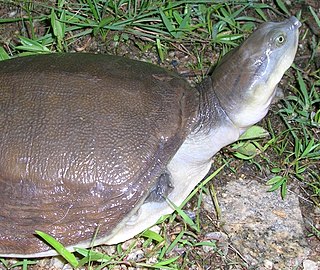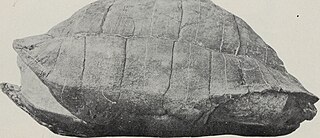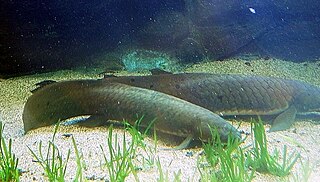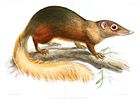
Colugos are arboreal gliding mammals that are native to Southeast Asia. Their closest evolutionary relatives are primates. There are just two living species of colugos: the Sunda flying lemur and the Philippine flying lemur. These two species make up the entire family Cynocephalidae and order Dermoptera.
Physeter is a genus of toothed whales. There is only one living species in this genus: the sperm whale. Some extremely poorly known fossil species have also been assigned to the same genus including Physeter antiquus from the Pliocene of France, and Physeter vetus from the Quaternary of the U.S. state of Georgia. Physeter vetus is very likely an invalid species, as the few teeth that were used to identify this species appear to be identical to those of another toothed whale, Orycterocetus quadratidens.

Pseudorca is a genus of cetaceans with three members which include Pseudorca yokoyamai, Pseudorca yuanliensis and Pseudorca crassidens, of which P. crassidens is the only extant member.

Caiman is a genus of caimans within the alligatorid subfamily Caimaninae. They inhabit Central and South America. They are relatively small sized crocodilians, with all species reaching lengths of only a couple of meters and weighing 6 to 40 kg on average.

Cetotherium is an extinct genus of baleen whales from the family Cetotheriidae.

Lissemys is a genus of softshell turtles in the subfamily Cyclanorbinae of the family Trionychidae. The genus is indigenous to southern Asia.

Cycloderma is a genus of softshell turtles in the subfamily Cyclanorbinae of the family Trionychidae. The genus is endemic to Africa.

Hadrianus is an extinct genus of tortoise belonging to the Testudinidae found in the United States, the Yolomécatl Formation of Mexico, the Alai Beds of Kyrgyzstan and Spain and believed to be the oldest true tortoise known. The genus is thought to be closely related to the genus Manouria. The genus may have evolved in the subtropics of Asia and subsequently migrated to North America and Europe.
Cosgriffius is an extinct genus of trematosaurian temnospondyl within the family Trematosauridae. It was described in 1993 by Samuel P. Welles based on a single partial skull from the well-known Meteor Crater Quarry in Arizona that also produced more abundant remains of the capitosaur Wellesaurus peabodyi. The skull was long and slender, features typically associated with the trematosaurid subfamily Lonchorhynchinae. This is the only trematosaurid known from western North America.
Osteophorus is an extinct genus of eryopoidean temnospondyl within the family Eryopidae. It is only known from the Permian of Poland.
Peltostega is an extinct genus of prehistoric trematosaurians. The type is the only known species, Peltostega erici It is known from the Early Triassic Kongressfjellet Formation of Svalbard and Jan Mayen.
Mioceratodus is an extinct genus of lungfish in the family Neoceratodontidae, which also contains the extant Queensland lungfish. It is known only from Oligocene and Miocene-aged sediments in Australia, although phylogenetic evidence supports it having first diverged from its closest relative, Neoceratodus, during the Late Jurassic or Early Cretaceous period.

Bocatherium is an extinct genus of tritylodonts from the Pliensbachian of Tamaulipas, Mexico. It is known only from a skull found at the Huizachal Canyon locality, "a Pliensbachian floodplain siltstone in the La Boca Formation".

Neoceratodontidae is a family of lungfish containing the extant Australian lungfish and several extinct genera. It and Lepidosirenidae represent the only lungfish families still extant.
Phosphatochelys is an extinct genus of bothremydid pleurodiran turtle that was discovered near Oued Zem, Morocco. The genus consists solely of type species P. tedfordi.
Labrostochelys is an extinct genus of bothremydid pleurodiran turtle that was discovered in the Ouled Abdoun Basin, Morocco. The genus consists solely of type species L. galkini.
Theroteinus is an extinct genus of haramiyidan mammaliaforms from the Late Triassic of France and Britain. It contains three species: T. nikolai,T. rosieriensis and T. jenkinsi, the former two of which are known exclusively from teeth found at the sand quarry of Saint-Nicolas-de-Port, while T. jenkinsi is known from a bedded sequence belonging to the Westbury Formation in a road cutting near Holwell, Dorset. Theroteinus is the only member of the family Theroteinidae and the suborder Theroteinida.

Sminthidae is a family of mouse-like jumping rodents. They are represented by only one extant genus, Sicista, represented by 19 species found throughout most of Eurasia, from central Europe east to Siberia, and south to southern China. However, they were much more diverse and had a much wider range in prehistoric times, having multiple genera and being found not only in Eurasia but also throughout North America, where they existed up to the early Pleistocene. They have a well-attested fossil record which dates as far back as the early Oligocene.

Thanatosdrakon is a genus of quetzalcoatline azhdarchid pterosaur from the Late Cretaceous Plottier Formation of the Neuquén Basin in western Argentina. The genus name is derived from the Greek words thanatos (=death) and drakon (=dragon), while the specific name is a Quechuan word meaning "flying serpent" and refers to the Incan deity Amaru. The type and only species is Thanatosdrakon amaru, known from two specimens consisting of several well-preserved axial and appendicular bones including material previously undescribed in giant azhdarchids. Thanatosdrakon is one of the oldest known members of the Quetzalcoatlinae. T. amaru lived from about 90 to 86 million years ago.
Megadolodus is an extinct genus of proterotheriid litopterns.















